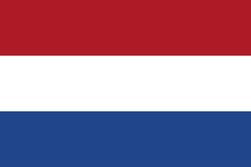Flag of the Netherlands
|
|
The national flag of the Netherlands, with its three equal horizontal bands coloured red (top), white and blue, was not the country's first flag. When, at the end of the 15th century, the majority of the Netherlands provinces were united under one lord, one common flag came into use for joint expeditions. This was the banner of the Lord of Burgundy, which consisted of a white field charged with two bundles of red laurel branches in the form of an X, with flames issuing from the intersection: the Cross of Burgundy. Under the later House of Austria, this flag remained in use.
The provinces of the Low Countries, however, rose in revolt against King Philip II of Spain, and the Prince of Orange placed himself at the head of the rebels. The Watergeuzen (pro-independence pirates), acting on his instructions, harassed the enemy everywhere they could and they did this under a tricolour Orange White Blue (Orange Blanche Bleu), the colours of the Prince's coat of arms. It was thus a flag easily associated with the leader of the rebellion, and the association was also expressed in the name: "the Prince's Flag." It is not known when this flag was unfurled for the first time, but it can be seen in illustrations dating from the earliest days of the Eighty Years' War, the Dutch war of independence.
The flag had three, sometimes six or even nine horizontal stripes, but also took the form of rays projecting from a circle. The colours were used without any fixed order and it was only towards the end of the 16th century that any degree of uniformity appeared. After 1630, the orange stripe was gradually replaced by a red one, as paintings of that time indicate. Since there was likely no political reason for introducing a non-orange motive in the flag, the probable reason is that orange and blue are faint colors and more difficult to distinguish than red and dark blue, especially at sea. An other explanation is that the orange was originally made of natural/herbal yellow and red. The yellow colour faded out the first, leaving a red strip.
The orange-white-blue flag, however, continued to be flown as well and in later times formed the basis for the South African flag. In addition to the two main flags, a third official flag, that of the States-General, came into being, although it never assumed the importance of the tricolour. Originally it consisted of the red lion of the province of Holland, taken from its coat of arms, on a gold field, and later, of a gold lion on a red field. It marked no contradistinction to the Prince's flag and, in old paintings of ships and sea battles, both flags may be seen flying harmoniously side by side, thus illustrating the complex form of government with its two centres of authority: the Stadtholder (who was always a member of the House of Orange) and the States General.
The revolution in the Netherlands, in the last decade of the 18th century, and the conquest by the French also resulted in another flag. The name "Prince's Flag" was forbidden. There came no change in the red-white-blue (colours to which the French "liberators" were kindly disposed, analogous as they were to their own tricolour), but in 1796 the red division of the flag was embellished with the figure of a Netherlands maiden, with a lion at her feet, in the upper left corner. In one hand she bore a shield with the Roman fasces and in the other a lance crowned with the cap of liberty. This flag had a life as short as that of the Batavian Republic for which it was created. Louis Bonaparte, made king of Holland by his brother the Emperor Napoleon, wished to pursue a purely Dutch policy and to respect national sentiments as much as possible. He removed the maiden of freedom from the flag and restored the old tricolour. His pro-Dutch policies led to conflicts with his brother, however, and the Netherlands were incorporated into the French Empire. Its flag was replaced by the imperial emblems.
In 1813, the Netherlands regained its independence and the Prince of Orange returned to the country from England. The tricolour reappeared from the attics and cellars where it had remained hidden for three years, waiting for better times. In order to demonstrate the attachment of the people to the House of Orange, the orange-white-blue and the red-white-blue fluttered together on the roofs. Which of the two flags should be the national flag was left undecided. Until recently, both had the same rights, although the red-white-blue was generally given precedence. This is apparent from the fact that it was not only hoisted on public buildings but also chosen by the first King as his personal standard, showing the national coat of arms on the white stripes. From the same period dates the custom, prescribed spontaneously by popular will, to fly an orange pennant together with the national flag as a sign of allegiance of the people to the House of Orange.
On February 19, 1937, a Royal Decree issued by Queen Wilhelmina finally laid down the red, white and blue colours as the national flag (heraldic colours of bright vermilion, white and cobalt blue).
Flags of provinces in the Netherlands
Drenthe - Friesland - Gelderland - Groningen - Limburg - North Brabant - North Holland - Overijssel - South Holland - Utrecht - Zeeland
| National flags |
| List of national flags | List of national coats of arms |
de:Flagge der Niederlande fr:Drapeau des Pays-Bas it:Bandiera olandese he:דגל הולנד nl:Vlag van Nederland ja:オランダの国旗 pl:Flaga Holandii pt:Bandeira dos Países Baixos ro:Steagul Olandei sv:Nederländernas flagga


